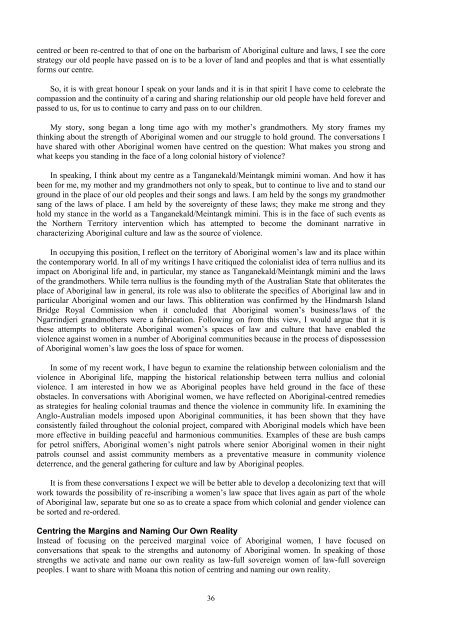traditional knowledge conference 2008 te tatau pounamu
traditional knowledge conference 2008 te tatau pounamu
traditional knowledge conference 2008 te tatau pounamu
Create successful ePaper yourself
Turn your PDF publications into a flip-book with our unique Google optimized e-Paper software.
centred or been re-centred to that of one on the barbarism of Aboriginal culture and laws, I see the corestra<strong>te</strong>gy our old people have passed on is to be a lover of land and peoples and that is what essentiallyforms our centre.So, it is with great honour I speak on your lands and it is in that spirit I have come to celebra<strong>te</strong> thecompassion and the continuity of a caring and sharing relationship our old people have held forever andpassed to us, for us to continue to carry and pass on to our children.My story, song began a long time ago with my mother’s grandmothers. My story frames mythinking about the strength of Aboriginal women and our struggle to hold ground. The conversations Ihave shared with other Aboriginal women have centred on the question: What makes you strong andwhat keeps you standing in the face of a long colonial history of violence?In speaking, I think about my centre as a Tanganekald/Meintangk mimini woman. And how it hasbeen for me, my mother and my grandmothers not only to speak, but to continue to live and to stand ourground in the place of our old peoples and their songs and laws. I am held by the songs my grandmothersang of the laws of place. I am held by the sovereignty of these laws; they make me strong and theyhold my stance in the world as a Tanganekald/Meintangk mimini. This is in the face of such events asthe Northern Territory in<strong>te</strong>rvention which has at<strong>te</strong>mp<strong>te</strong>d to become the dominant narrative incharac<strong>te</strong>rizing Aboriginal culture and law as the source of violence.In occupying this position, I reflect on the <strong>te</strong>rritory of Aboriginal women’s law and its place withinthe con<strong>te</strong>mporary world. In all of my writings I have critiqued the colonialist idea of <strong>te</strong>rra nullius and itsimpact on Aboriginal life and, in particular, my stance as Tanganekald/Meintangk mimini and the lawsof the grandmothers. While <strong>te</strong>rra nullius is the founding myth of the Australian Sta<strong>te</strong> that obli<strong>te</strong>ra<strong>te</strong>s theplace of Aboriginal law in general, its role was also to obli<strong>te</strong>ra<strong>te</strong> the specifics of Aboriginal law and inparticular Aboriginal women and our laws. This obli<strong>te</strong>ration was confirmed by the Hindmarsh IslandBridge Royal Commission when it concluded that Aboriginal women’s business/laws of theNgarrindjeri grandmothers were a fabrication. Following on from this view, I would argue that it isthese at<strong>te</strong>mpts to obli<strong>te</strong>ra<strong>te</strong> Aboriginal women’s spaces of law and culture that have enabled theviolence against women in a number of Aboriginal communities because in the process of dispossessionof Aboriginal women’s law goes the loss of space for women.In some of my recent work, I have begun to examine the relationship between colonialism and theviolence in Aboriginal life, mapping the historical relationship between <strong>te</strong>rra nullius and colonialviolence. I am in<strong>te</strong>res<strong>te</strong>d in how we as Aboriginal peoples have held ground in the face of theseobstacles. In conversations with Aboriginal women, we have reflec<strong>te</strong>d on Aboriginal-centred remediesas stra<strong>te</strong>gies for healing colonial traumas and thence the violence in community life. In examining theAnglo-Australian models imposed upon Aboriginal communities, it has been shown that they haveconsis<strong>te</strong>ntly failed throughout the colonial project, compared with Aboriginal models which have beenmore effective in building peaceful and harmonious communities. Examples of these are bush campsfor petrol sniffers, Aboriginal women’s night patrols where senior Aboriginal women in their nightpatrols counsel and assist community members as a preventative measure in community violencede<strong>te</strong>rrence, and the general gathering for culture and law by Aboriginal peoples.It is from these conversations I expect we will be bet<strong>te</strong>r able to develop a decolonizing <strong>te</strong>xt that willwork towards the possibility of re-inscribing a women’s law space that lives again as part of the wholeof Aboriginal law, separa<strong>te</strong> but one so as to crea<strong>te</strong> a space from which colonial and gender violence canbe sor<strong>te</strong>d and re-ordered.Centring the Margins and Naming Our Own RealityIns<strong>te</strong>ad of focusing on the perceived marginal voice of Aboriginal women, I have focused onconversations that speak to the strengths and autonomy of Aboriginal women. In speaking of thosestrengths we activa<strong>te</strong> and name our own reality as law-full sovereign women of law-full sovereignpeoples. I want to share with Moana this notion of centring and naming our own reality.36
















